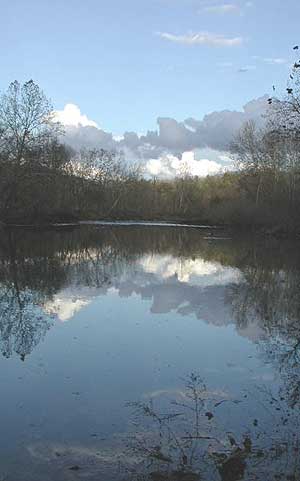
|
|
||
One Garden and the Bryant Creek Atlas at watersheds.org
By Peter Callaway
 I
live at Elixir in a valley along Bryant Creek, the quality of whose spring-fed
flow depends on the quality of its 584 square mile watershed. I like to
swim, so I want to keep our river healthy. I asked myself, what, in an
area of few people and perhaps some hostility to environmentalism, could
I do? My thought was that I could at least begin collecting information
that might turn out be helpful when enough people began to care about
our watershed. That was in1996.
I
live at Elixir in a valley along Bryant Creek, the quality of whose spring-fed
flow depends on the quality of its 584 square mile watershed. I like to
swim, so I want to keep our river healthy. I asked myself, what, in an
area of few people and perhaps some hostility to environmentalism, could
I do? My thought was that I could at least begin collecting information
that might turn out be helpful when enough people began to care about
our watershed. That was in1996.
My questions were: How to collect the information? What kind of information? Where to put it? I considered a website. Websites were becoming important as media. They could be readily updated and make information quickly and widely available. I gathered a group of interested local folks, and we began to imagine a website, The Bryant Watershed Atlas.
We decided that we needed more of a purpose than simply to collect information for the future; that we wanted people to care about the watershed; that they had to know what a watershed is; that we needed to start with kids (parents tend to be too busy, too distracted, too set in their thinking). Perhaps most importantly, we saw that ‘watershed’ included everything within it: the land, the water, the air, the climate, the people, their history & culture, economy, health and society. And that the health of a stream depends on the health of its watershed, and that includes the health and wellbeing of the people who live and/or work there.
So our Atlas became www.watersheds.org, an educational website for local schools, with material about the environment of course, but also about history and so forth. Some of us collected information, created maps, got articles written, researched in local historical societies; others figured out how to create a website; two of us, former school teachers, connected with Bryant area schools, particularly with individual teachers. Teachers then were timid about computers and the internet, and schools had only the most rudimentary ‘computer labs.’ We persisted; we went into classrooms and helped teachers learn to use our Atlas. We held focus groups to see what worked, what didn’t, and what they wanted in the Atlas.
Our initial funding was private, then in 2004 we received a state grant to extend our website and programs to three adjacent watersheds and their elementary and middle schools. The website we created has become more immediately useful and successful, perhaps, but it has less depth and perhaps long-term utility than I had originally hoped for the Bryant Atlas.
So in my association with One Garden, I hope to extend and deepen the original concept as it applies to our Bryant Creek watershed. For example, One Garden might become content development sponsor for the Bryant Atlas at watersheds.org. One Garden, coming from a longer-term and more integral point of view, could sponsor the Atlas to develop more sophisticated kinds of information and programs for higher-level students. With the Botanical Garden, the Atlas could develop and maintain animal and plant species inventories; with Ozark Regional Land Trust (which stewards thousands of acres in our watershed) it could sponsor surveys of high-value areas, on-going studies of construction of infrastructure in the watershed, surveys of human well-being and needs, etc. Such information could feed into Alford Forest land-use programs and ideas for economic development in the watershed. Overall, the Atlas could become an on-going information resource for citizens of our watershed as they are faced with personal and political decisions.

Hosted by Institute for Global Communications